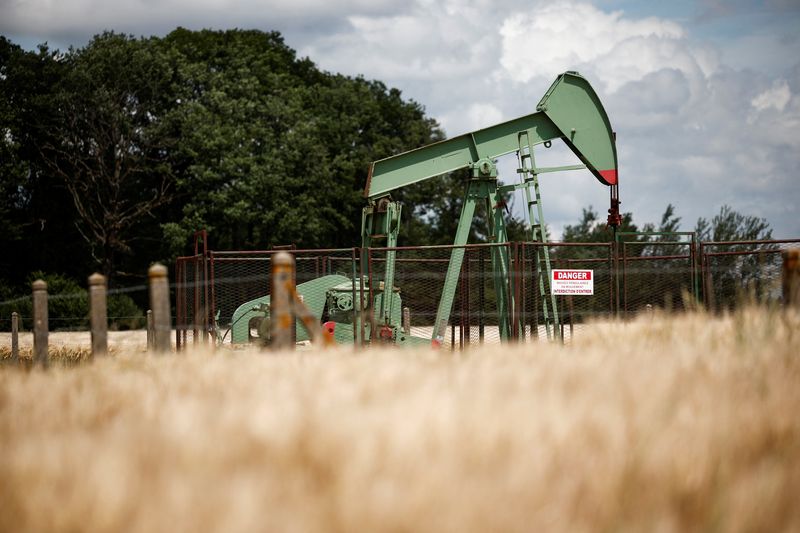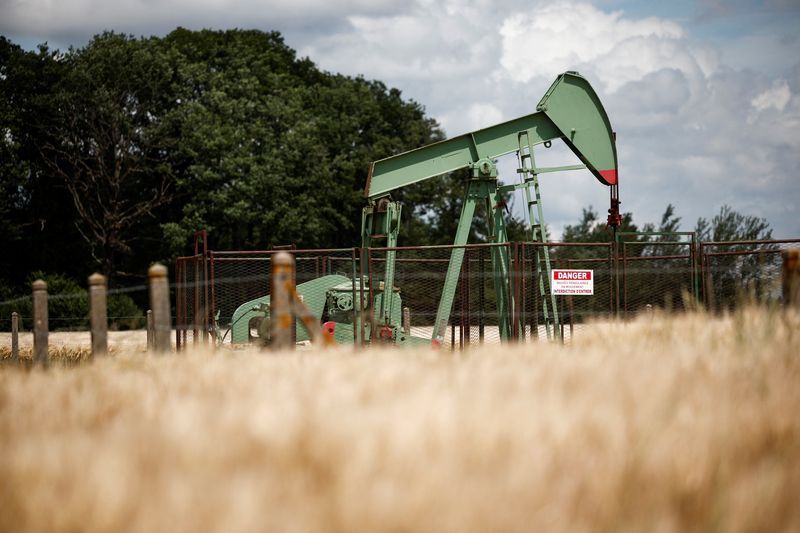Commodities
Oil prices drop as US recession fears spark broader selloff

By Paul Carsten
London (Reuters) -Oil futures extended losses in a volatile session on Monday, trailing a stock market selloff sparked by fears of a U.S. recession, though declines were buffered by worries that spreading conflict in the Middle East could hit crude supplies.
Share markets tumbled across Asia as U.S. recession fears sent investors rushing from risk assets while wagering that rapid interest rate cuts will be needed to drive economic growth.
futures dropped $1.07, or 1.4%, to $75.74 a barrel by 1128 GMT, with prices trading around their lowest since January. U.S. West Texas Intermediate crude was down $1.18, or 1.6%, at $72.34.
U.S. recession concerns stoked by Friday’s weak July payrolls report “only add to Chinese demand concerns that have been lingering in the oil market for some time”, ING analysts led by Warren Patterson said in a note.
Slumping diesel consumption in China, the world’s biggest contributor to oil demand growth, is also weighing on oil.
The decline in oil prices closely trailed falls in European stock markets. , 40, and Spain’s all lost more than 2%.
But even with the latest selloff, oil has still underperformed many major stock exchanges in 2024. Since the beginning of the year the has risen 11% and the FTSE 3%, while Brent crude is down 0.3%
Oil has also been pressured by the decision of the OPEC+ group of producers to stick to its plan to phase out voluntary output cuts from October, which means that supplies will rise later this year, analyst say.
OPEC oil output rose in July despite production cuts by the group, a Reuters survey showed on Friday.
However, oil losses were capped by geopolitical risks in the Middle East. Fighting in Gaza continued on Sunday, a day after an unsuccessful round of ceasefire talks in Cairo.
Israel and the United States are bracing for a serious escalation in the region after Iran and its allies Hamas and Hezbollah pledged to retaliate against Israel for the killings of Hamas’s leader and a top Hezbollah military commander last week.
“The risk of a wider regional war, while I still think is small, can’t be ignored,” said Sydney-based IG market analyst Tony Sycamore.

Investors are also awaiting U.S. services data for last month to gauge the health of the world’s largest economy, Sycamore said.
“Another fall tonight and it supports the idea the Fed is behind the curve,” he said, referring to the U.S. central bank’s delays to interest rate cuts.
Commodities
Oil prices rise; U.S. crude inventories plunge, Russia-Ukraine truce eyed
Commodities
India’s Reliance to stop buying Venezuelan oil over US tariffs, sources say
Commodities
Oil prices climb on Venezuela supply worries

 Forex3 years ago
Forex3 years agoForex Today: the dollar is gaining strength amid gloomy sentiment at the start of the Fed’s week

 Forex3 years ago
Forex3 years agoUnbiased review of Pocket Option broker

 Forex3 years ago
Forex3 years agoDollar to pound sterling exchange rate today: Pound plummeted to its lowest since 1985

 Forex3 years ago
Forex3 years agoHow is the Australian dollar doing today?

 Cryptocurrency3 years ago
Cryptocurrency3 years agoWhat happened in the crypto market – current events today

 World3 years ago
World3 years agoWhy are modern video games an art form?

 Commodities3 years ago
Commodities3 years agoCopper continues to fall in price on expectations of lower demand in China

 Economy3 years ago
Economy3 years agoCrude oil tankers double in price due to EU anti-Russian sanctions























